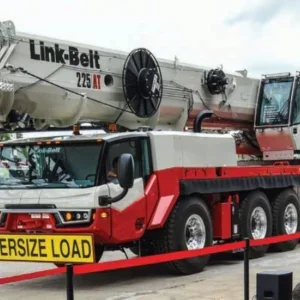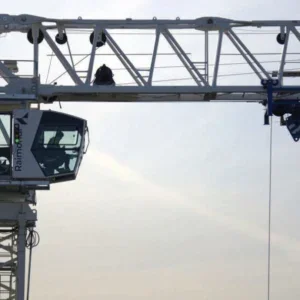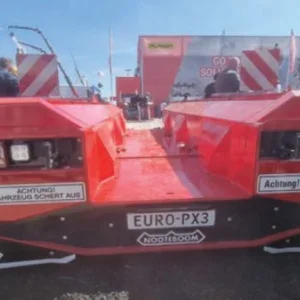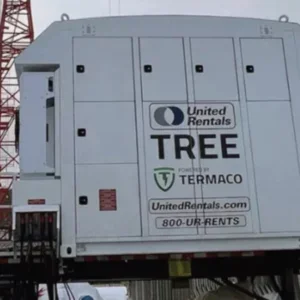The rental company needed to use such large cranes because customer DeBoer, which assembled the structure, imposed a 25% safety margin.
The lift itself took about two hours, according to lift supervisor Stuart Chorley. The cranes, set up on the long side of the 80m x 65m (260ft x 210ft) roof, raised it off its half-metre supports until it was hanging free. The team plumbed the cranes, and hung marker tapes down from the structure in front of the crane operators. The marker tapes were marked in 300mm increments.
The marquee was raised in a seesaw motion to final 9m height. First three cranes on one side raised the marquee one marker high, and then the other three raised the other side to level. Each crane was numbered, and operators reported on a shared radio channel as they reached level.
This seesaw motion controlled the maximum difference in height of a single crane hook. If a hook were more than 300mm (1ft) out, the roof could have collapsed, Chorley says.
Once the roof was raised, the cranes held it for six hours as a team of technicians erected supporting walls with telehandlers, forklifts and aerial work platforms.
The structure was set up in a field behind London’s St Pancras train station. With the soft ground conditions, the main customer agreed to lay 3,000t of stone and concrete chunk (hardcore) over the entire area, and compacted it. Then two 120m stretches of trackway were laid to help the cranes reach the site.
“We had a lot of ground issues initially,” Chorley says. On top of the trackway, Hewden put down 5 m sq mats, and then steel pads on top, to reduce ground loadings to 3.4t per sq m. Extra attention was paid to the ground and matting, because people had to work underneath the suspended load.
Any potentially dangerous situation would have been signalled with a radio message and the crane horns would sound for an immediate evacuation.
Below-the-hook rigging was also beefed up. Working from DeBoer’s specification of lifting points, Hewden bought 48 10t-capacity slings for the lift. Each crane hook had a four-point pick, using four wire ropes each shackled to a 2m endless soft sling wrapped around the aluminum truss. Sling angles had to be checked by the customer.
Hewden sent a team of 11; six crane drivers, two lift supervisors, two riggers and Chorley in charge as the appointed competent person.
The roof structure, when complete with two other 25m-long sections that Hewden installed, was used as a marquee for a party hosted by Union Rail commemorating the completion of the Channel Tunnel Rail Link from a new terminal in London to Paris. In fact, the day of the lift the train set a new speed record, 186mph (300km/hr) in a 100-minute journey from Brussels, Belgium.
A week after the tent was installed, Hewden came back and took it down again.
Six Demag AC 100s raise the roof together Six Demag AC 100s raise the roof together Workers in aerial platforms begin erecting support beams as the cranes hold up the roof Workers in aerial platforms begin erecting support beams as the cranes hold up the roof The cranes set up The cranes set up






